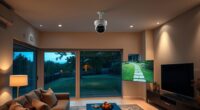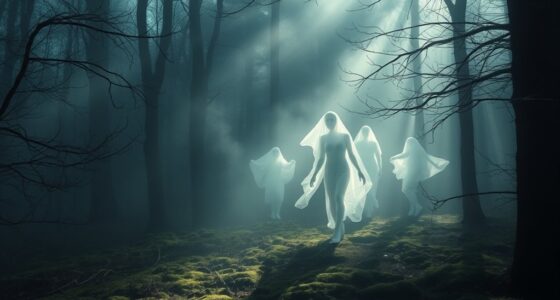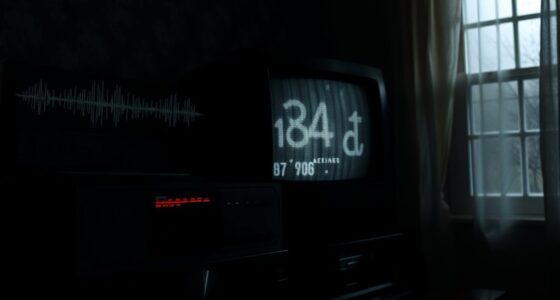Shadow people are dark, humanoid figures that often appear in your peripheral vision or during moments of stress, exhaustion, or sleep disturbances. You might see them fleetingly or feel like you’re being watched, especially during sleep paralysis when hallucinations can occur. These encounters are linked to sleep issues, stress, and fatigue, and their true nature remains unclear—some see them as supernatural, others as hallucinations. If you keep exploring, you’ll uncover more about what these mysterious figures could mean.
Key Takeaways
- Shadow people are dark, humanoid silhouettes often seen in peripheral vision during heightened emotional or sensory-deprived states.
- They are commonly associated with sleep disturbances like sleep paralysis and vivid, unsettling dreams.
- Encounters may be hallucinations caused by stress, fatigue, or neurological factors affecting perception.
- Theories suggest they could be portals, spirits, or manifestations of negative energy, but their true nature remains uncertain.
- Improving sleep hygiene and managing stress can help reduce the frequency and intensity of shadow person encounters.

Have you ever sensed a dark, fleeting figure lurking just out of sight? That nagging feeling that someone or something is nearby, even when your room is empty? You’re not alone. Many people report encounters with shadow people, which are often described as dark, humanoid silhouettes that seem to materialize in their peripheral vision. These experiences tend to happen during moments of heightened emotion, exhaustion, or vulnerability. Some see them during paranormal encounters, while others notice strange disturbances in their sleep. Shadow people are commonly linked to sleep disturbances, especially when you’re waking up in the middle of the night or experiencing vivid, unsettling dreams. Such disturbances can leave you feeling disoriented and anxious, making it harder to distinguish between reality and hallucination. The connection between sleep issues and shadow sightings isn’t accidental; sleep paralysis, in particular, often accompanies these encounters. During sleep paralysis, your body’s natural paralysis keeps you from acting out dreams, but it can also trap your consciousness in a state where visual and auditory hallucinations emerge. That’s when shadow people tend to appear, often in the corner of your room or just beyond your line of sight. These experiences can be terrifying, especially if you’re unsure whether they’re real or a product of your mind. Many describe a sudden rush of fear, as if they’re being watched, or a feeling of malevolence emanating from the shadowy figure. It’s important to recognize that these encounters, while unsettling, are often linked to natural sleep phenomena rather than supernatural entities. They could be a result of your brain trying to process stress, fatigue, or sensory deprivation during the night. The ambiguity of shadow people’s presence makes it difficult to determine whether they’re purely hallucinations or something more. Despite the lack of concrete evidence, these experiences leave a lasting impression, prompting many to seek explanations or reassurance. Some believe shadow people are portals to other dimensions, spirits, or manifestations of negative energy, while others see them as mere figments of a fatigued mind. Recognizing the psychological and neurological factors involved can help demystify these encounters. Regardless of their origin, it’s clear that sleep disturbances profoundly influence these paranormal encounters. If you find yourself frequently waking up disturbed or seeing shadowy figures, it’s worth paying attention to your sleep hygiene. Reducing stress, establishing a calming bedtime routine, and ensuring you get enough rest can help minimize these unsettling episodes. Remember, your mind is powerful, and understanding the connection between sleep disturbances and shadow sightings can help you regain control. Recognizing the patterns and triggers allows you to address them directly, making those dark figures less threatening and more a part of your sleep story than a supernatural invasion.
Frequently Asked Questions
Can Shadow People Influence or Control Human Thoughts?
Shadow people can’t directly influence or control your thoughts through paranormal influence or thought manipulation. They appear as fleeting figures and aren’t proven to possess any mind-controlling abilities. If you’re feeling anxious or paranoid about shadow figures, focus on grounding techniques and seek mental health support if needed. Remember, these entities are likely illusions or manifestations of subconscious fears, so maintaining a clear mind can help reduce their perceived influence.
Are Shadow People More Active During Specific Times of Day?
You might notice shadow people more during nighttime phenomena, as darkness makes their fleeting forms easier to perceive. While some say they’re less active during daytime sightings, others believe they’re quietly lurking, waiting for the right moment. Their activity seems to ebb and flow with the hours, often more prominent when the world is quiet and shadows deepen. Trust your instincts during these moments—your awareness may reveal more than you think.
What Are the Psychological Effects of Witnessing Shadow People?
Witnessing shadow people can lead to significant psychological effects, including sleep disturbances and increased anxiety symptoms. You might find it hard to fall asleep or stay asleep, fearing what you saw. The anxiety can become overwhelming, causing feelings of fear or paranoia. These experiences may also lead to stress or difficulty concentrating during the day. If you notice these effects, it’s important to seek support from a mental health professional to address your concerns.
Do Shadow People Appear More Frequently in Certain Locations?
They tend to appear more often in specific location patterns, especially in places with low lighting or high tension, like abandoned buildings or bedrooms at night. You might notice cultural interpretations influence how often they seem to show up, as some areas have stories or beliefs that make shadow people more prevalent. Remember, where there’s smoke, there’s fire, so stay aware of your surroundings and trust your instincts.
How Can One Differentiate Shadow People From Hallucinations?
You can differentiate shadow people from hallucinations by examining your paranormal perception and visual anomalies. Shadow people often appear as dark, humanoid figures with consistent shapes, usually in low light or during shifts between wakefulness and sleep. Hallucinations tend to be less defined, may involve other senses, and often occur during stress or fatigue. Trust your intuition and consider context—shadow people tend to seem more intentional than random visual anomalies.
Conclusion
As you step back from these shadowy figures, remember they’re like whispers in a foggy night—elusive and mysterious. While they may stir curiosity or unease, understanding their nature can help you feel more grounded. Just as a lighthouse guides ships through darkness, knowledge can illuminate the unknown. Keep your wits sharp and your mind open, knowing that sometimes, what lurks in the shadows is simply a part of life’s mysterious tapestry, waiting to be understood.









